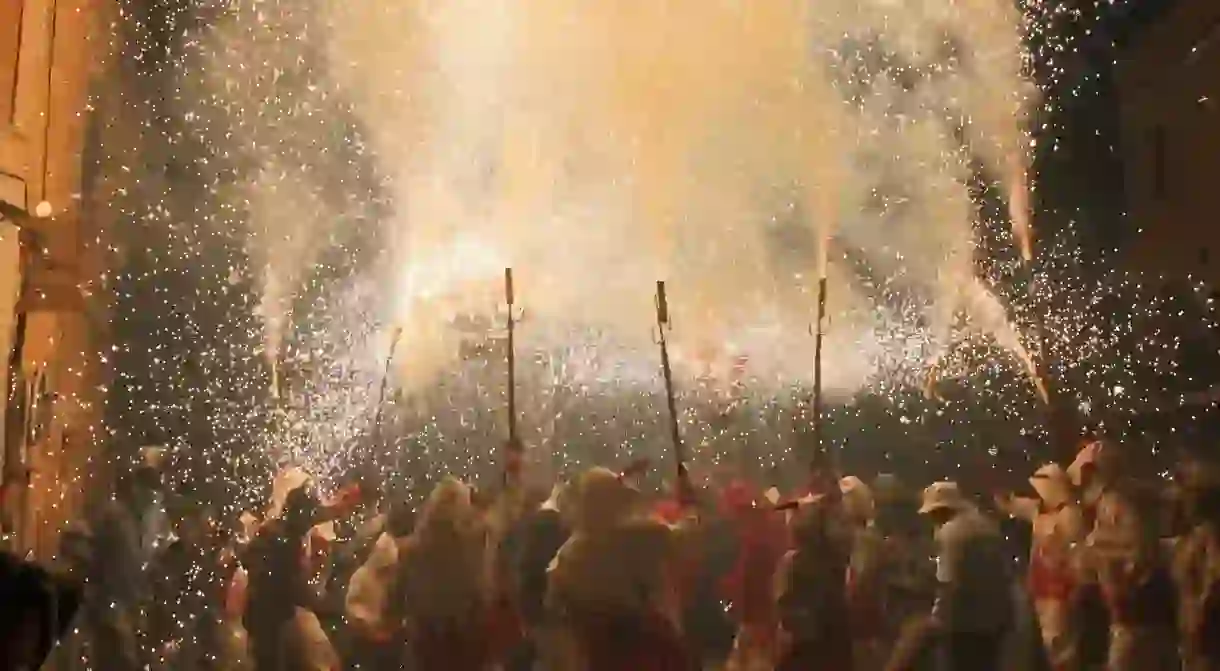The Story Behind the Festival of San Juan and the Correfoc

For one night in Spain‘s island of Mallorca, pagan, Christian and mystical tradition come together in an electric melting pot for the festival of San Juan. Here we share the story behind the traditions, as well as what to expect if you’re in town for the festivities.
Background
The festival of San Juan (Sant Joan in Catalan) or St John the Baptist, is one of the bigger annual festivals celebrated on Mallorca. Originating in pre-Christian ritual, it aligns with the summer solstice of the Northern Hemisphere. It takes place on the shortest night of the year, usually around June 20-24, and symbolises the triumph of light over dark.
Regional variations
It is celebrated throughout Spain, adopting particular celebrations dependent on where you are. For example in Menorca, black horses ride through the streets, while in Alicante it is their most important festival of the year, and people burn old furniture on street bonfires. Wherever you are, there is a running theme based on legends, tradition and magical ritual that include fire, water and the sun.
http://instagram.com/p/BPf7qZ_h5NJ/?tagged=correfocmallorca
Fiery traditions
It was believed that the fires of San Juan would kill off any bad spirits still lurking in the dark and even cure disease. Fire was also considered to cleanse the soul, and water to recuperate it. Tradition dictated that if people jumped over a bonfire three times on the feast of San Juan night, they would be cleansed and purified, and their problems would be burnt away.
Pagan ritual
People also considered the shortest night of the year to be when pagan gods were closest to humans, and as such paranormal events were more likely to take place. It was also believed to be a night of heightened superstition – so if you wanted to be lucky in the year ahead, you’d have to jump over one of the bonfires, burn something old to release bad spirits, wash your face in the sea, river or lake, or go for a swim after midnight to purify the body and soul.
http://instagram.com/p/BIPNTjfBdqZ/?tagged=correfocmallorca
Celebrations today, and the Correfoc
In present-day Mallorca you can enjoy festivities on the beach or in town, where you’ll find bonfires and people dressed in white, burning ceremonial candles, enjoying food together and generally partying the night away.
As San Juan is the patron saint of four Mallorcan towns – Deià, Manacor de la Vall, Muro and Son Servera – in these spots you’ll find more extensive celebrations over the whole week, sometimes even longer.
In Palma de Mallorca, the public holiday is preceded by Nit de Foc (‘Night of Fire’), which includes one of the more ritualistic traditions called the Correfoc, or Fire Run. This is an additional Catalonian tradition which accompanies a few festivals throughout the year such as the Fiesta de San Sebastian (the patron saint of Palma) in January every year. It can take many forms, but is always based around the use of fire and fireworks used in symbolic ritual of good versus evil.
http://instagram.com/p/BPtD_LwjvcZ/?tagged=correfocmallorca
Where to join in
In Palma de Mallorca the festivities take place in Parc del Mar below the Cathedral. A child-friendly event runs earlier in the evening and is a chance for children to get dressed up as little devils to conduct their own parade, while the later, post-watershed version takes place at 10pm.
Under the cloak of darkness, masked devils and horrifying-looking creatures holding pitchforks and sticks of fire charge towards the crowd, accompanied by a soundtrack of tribal drumming from the devilish-looking percussion band. Historically, this was a chance for valiant young men to show their bravery by jumping the flames coming from the devils. Nowadays, young men head into the hubbub among the devils and demons to jump the sparks being launched towards their feet, first making sure to be fully covered from head to toe as protection from injury.
It’s a celebration unique to Hispanic culture, a celebration you’ll be hard to find in more safety conscious countries(!) and something – if you find yourself in Mallorca at the right time – certainly not to be missed.













